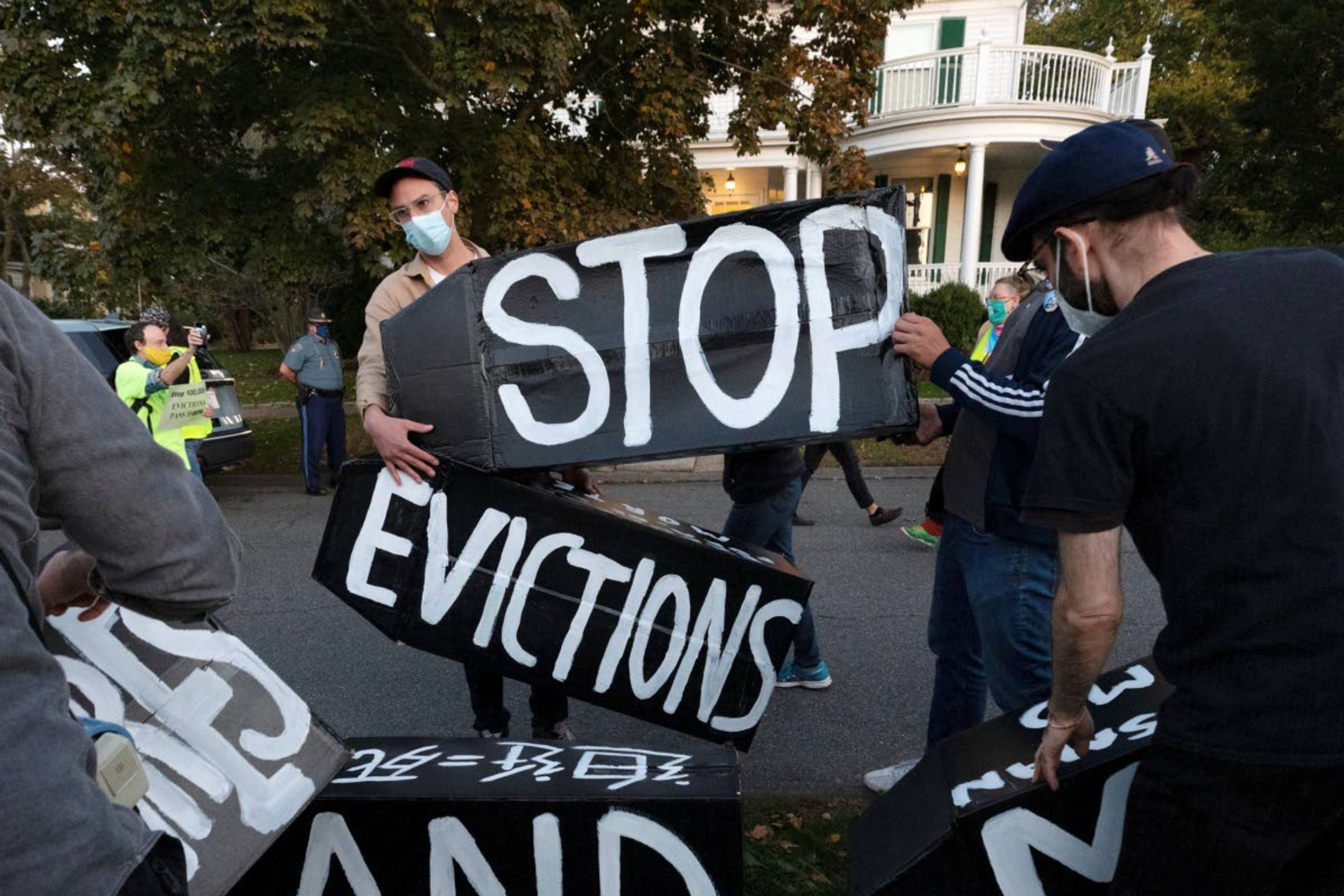A federal freeze on most evictions enacted last year is scheduled to expire July 31, after the Biden administration extended the date by a month. The moratorium, put in place by the Centers for Disease Control and Prevention in September, was the only tool keeping millions of tenants in their homes. Many of them lost jobs during the coronavirus pandemic and had fallen months behind on their rent.
Landlords successfully challenged the order in court, arguing they also had bills to pay. They pointed out that tenants could access more than $45 billion in federal money set aside to help pay rents and related expenses.
Advocates for tenants say the distribution of the money has been slow and that more time is needed to distribute it and repay landlords. Without an extension, they feared a spike in evictions and lawsuits seeking to boot out tenants who are behind on their rents.
As of June 7, roughly 3.2 million people in the U.S. said they face eviction in the next two months, according to the U.S. Census Bureau’s Household Pulse Survey. The survey measures the social and economic effects of the coronavirus pandemic every two weeks through online responses from a representative sample of U.S. households.
Here’s the situation in Idaho:
EVICTION MORATORIUMS — The only moratorium in Idaho is the one issued by the Centers for Disease Control and Prevention to reduce the chances of homeless people spreading the coronavirus. It ends July 31.
THOSE FACING EVICTION — The state received $15 million in CARES Act money last year that was used through Jan. 18 to help people who couldn’t pay rent because of the coronavirus pandemic. The state received another $175 million in federal coronavirus relief money to continue the program through Sept. 30, 2022. The Idaho Housing and Finance Association has been distributing the money, except in highly populated Ada County in southwestern Idaho. Officials with the association said the initial $15 million has been spent as well as $6 million of the $175 million. The Boise City/Ada County Housing Authorities has been distributing federal relief money it received in the city and county.
EVICTION HEARINGS — Courts shut down for about a month in the spring of 2020 but have been meeting virtually since then. Ali Rabe of the Jesse Tree of Idaho, which works to prevent homelessness in the southwestern part of the state, said that has made it difficult for some people facing eviction who don’t have access to the Internet or are unfamiliar with how to participate online. She said that has resulted in renters having a default judgement against them for failing to appear at a court hearing.
Documentation required of renters to meet requirements of the relief program has been challenging for some eligible renters, causing them to fail to qualify, Rabe said.
AFFORDABILITY — Idaho is among the fastest-growing states, and home prices are skyrocketing in urban areas. That is also causing the price of rental homes to shoot up. The National Low Income Housing Coalition said there is a shortage of affordable rental homes available to low-income households in Idaho. It says the annual household income needed to rent a two-bedroom home is $34,500.
STATE OF HOMELESSNESS — Officials said they expect more people to become homeless once the moratorium ends. “We believe that the moratorium is creating a disincentive for some landlords to file eviction, but not all,” said Rabe, who is also a Democratic state senator. “But we anticipate those landlords will take the opportunity to file when the moratorium lifts.”
Here’s the situation in Washington:
EVICTION MORATORIUMS — Washington is one of several states that enacted a moratorium last year halting eviction proceedings. Evictions with a 60-day notice are allowed in cases in which the landlord intends to sell or move into the property, or if an affidavit declares the tenant created health and safety problems.
Gov. Jay Inslee has extended the moratorium several times, including this past week. The protections will now remain in force until Sept. 30 to give landlords and tenants sufficient time to access federal aid.
Through the end of July, landlords are prohibited from evicting tenants for past-due rent during the pandemic until rental assistance and eviction resolution programs are in place in their county. Starting Aug. 1, tenants are expected to pay full rent unless they negotiate a lower amount with their landlord or actively seek rental assistance. Landlords must offer tenants a reasonable repayment plan before starting the eviction process and provide them a list of services and support available to them under the assistance programs.
THOSE FACING EVICTION — The Legislature approved spending $658 million in federal money to extend the state’s rental assistance program. That doesn’t include hundreds of millions of dollars from previous federal relief programs that are being distributed to landlords. The ultimate number of households to be helped is expected to be more than 80,000, said Jaime Smith, spokeswoman for the state Department of Commerce.
The governor also signed a “right to counsel” measure passed by the Legislature that ensures low-income tenants have legal representation when faced with eviction. Another one focuses on tenant rights and the circumstances in which they can be evicted.
EVICTION HEARINGS — In most judicial districts, eviction hearings in Washington continue to be held remotely. In any given year, the courts receive 17,000 to 20,000 eviction filings across the state, said Edmund Witter, an attorney with the King County Bar Association’s Housing Justice Project. While the number has decreased during the pandemic, he expects the pace will resume once the moratorium lifts.
Recent statewide data shows just 2,700 eviction filings in 2020, said Jim Bamberger, director of the Office of Civil Legal Aid, a judicial branch agency.
AFFORDABILITY — Washington has had a tight rental market for several years, with vacancy rates at 5 percent or below, said James Young, director of the Washington Center for Real Estate Research, which looks at data for rental buildings that have at least 20 units. From spring 2015 to spring 2021, the statewide average rent for a two-bedroom apartment increased more than 37 percent, to $1,476, according to state data. One-bedroom apartments saw a 30 percent jump during that same period to a statewide average of $1,422. This spring, one-bedroom apartments in most counties outside the Puget Sound area had vacancy rates below 2 percent.
During the pandemic, the state saw a shift away from urban areas as people looked for cheaper housing while working remotely. That’s why King County, home to Seattle, had the largest vacancy rate at 7.1 percent this spring, compared with smaller markets that had a rental vacancy of 0.5 percent in a recent survey.
Data on multifamily units of five and larger from CoStar Group, a real estate research firm, shows that as the economy reopens, demand for housing in Seattle is coming back after vacancy rates were as high as 11.4% last year, and rents are increasing again after seeing a decline.
Seattle rents increased 4.4 percent over the past 12 months, with a one-bedroom at $1,674 and a two-bedroom rate at $1,983.
STATE OF HOMELESSNESS — It’s hard to say how much homelessness will increase in Washington. Witter, with the Housing Justice Project, said the Seattle region already has one of the highest homelessness rates in the country, which could increase if pandemic-related evictions soar. According to the Census Pulse Survey for the week of May 26-June 7, about 13,000 households statewide are not paying rent and more than 40,000 have “no confidence” they could pay next month’s rent.
The Census survey found that more than 10,000 respondents said it was “very likely” they would have to leave their homes because of eviction in the next two months. More than 30,000 said it was “somewhat” likely. “It doesn’t take a lot to create a surge of homelessness,” Witter said.









